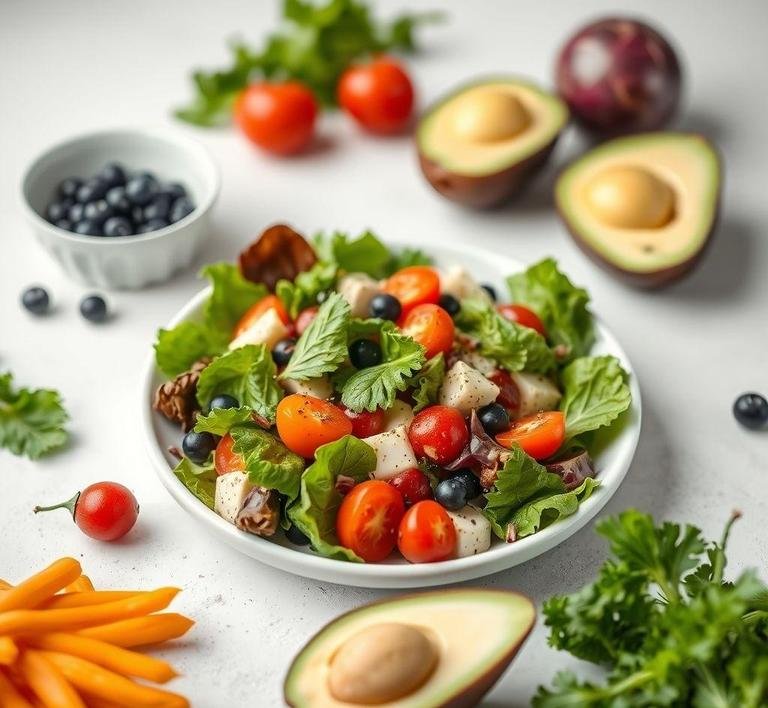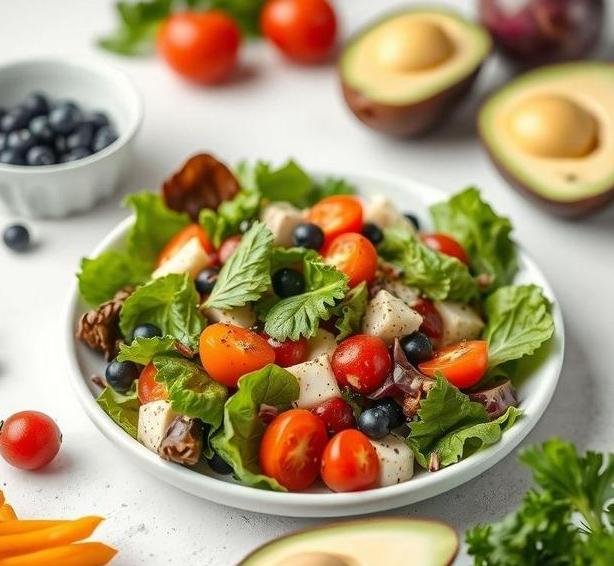Mary Berry’s Superfood Salad is a vibrant, nutrient-packed dish that beautifully marries the concept of wholesome nutrition with delicious, fresh flavors. Renowned for her approachable yet sophisticated cooking style, Mary Berry crafted this salad as a celebration of nature’s best ingredients-each chosen for its health benefits as well as its flavor and texture.
The term ‘superfood’ is often tossed around, but in this context, it refers to ingredients rich in vitamins, minerals, antioxidants, and fiber that contribute to overall wellness. This salad is a colorful medley of leafy greens, seeds, nuts, berries, and sometimes grains, all tossed together with a zingy dressing. It’s more than just a side dish; it’s a complete sensory experience and a powerhouse of nutrition designed to energize and satisfy.
What makes this salad truly stand out is Mary Berry’s signature touch of balancing textures-think crunchy seeds, juicy berries, creamy avocado, and crisp greens-and the harmonious interplay of sweet, tangy, and savory notes in the dressing. It’s a perfect example of how healthy eating doesn’t have to be boring or bland. It’s vibrant, fresh, and utterly delightful on the palate.
Mary Berry’s Superfood Salad Recipe
Ingredients Needed

To craft Mary Berry’s Superfood Salad, you’ll need a careful selection of fresh, nutrient-dense ingredients. Here’s a comprehensive list that captures the essence of the salad’s health benefits and flavor profile:
- Mixed Salad Leaves: A combination of baby spinach, rocket (arugula), watercress, and kale provides a rich base loaded with vitamins A, C, and K, as well as iron and antioxidants.
- Quinoa: This ancient grain is a fantastic source of plant-based protein, fiber, and essential amino acids.
- Avocado: Creamy and rich in heart-healthy monounsaturated fats, avocado adds luxurious texture and boosts nutrient absorption.
- Pomegranate Seeds: Bursting with juicy sweetness and antioxidants, these ruby-red seeds offer a beautiful contrast in both color and flavor.
- Chia Seeds: Tiny but mighty, chia seeds are packed with omega-3 fatty acids, fiber, and protein, adding a subtle crunch.
- Pumpkin Seeds: Toasted for extra depth, these seeds contribute magnesium, zinc, and a satisfying crunch.
- Blueberries: These antioxidant-rich berries lend a sweet, tangy note and a pop of color.
- Red Onion: Thinly sliced, it adds a gentle pungency and a bit of crunch.
- Cherry Tomatoes: Juicy and sweet, they brighten the salad with bursts of freshness.
- Fresh Herbs: Parsley or coriander adds a fresh, aromatic lift.
- Lemon Juice: For acidity and brightness, helping to balance the richness of avocado.
- Extra Virgin Olive Oil: A staple in Mary’s dressing, providing healthy fats and a smooth finish.
- Honey or Maple Syrup: Just a touch to round off the dressing with subtle sweetness.
- Salt and Freshly Ground Black Pepper: To season and enhance the flavors.
Equipment Needed
Creating this superfood salad is simple and requires only basic kitchen tools, which makes it perfect for home cooks of all skill levels:
- Large Mixing Bowl: To toss all the ingredients together comfortably.
- Small Bowl or Jar: For preparing the dressing.
- Whisk or Fork: To emulsify the dressing ingredients smoothly.
- Measuring Spoons: For precise quantities of dressing components.
- Sharp Knife: Essential for slicing the avocado, red onion, and cherry tomatoes.
- Cutting Board: To provide a safe surface for chopping.
- Colander or Fine Mesh Sieve: Useful for rinsing quinoa and draining it after cooking.
- Saucepan: For cooking quinoa.
- Toaster or Oven (optional): For toasting pumpkin seeds to intensify their flavor and crunch.
- Salad Servers or Tongs: To mix and serve the salad neatly.
Instructions To Make Mary Berry’s Superfood Salad
Step 1: Prepare the Quinoa
Start by rinsing ½ cup of quinoa thoroughly under cold running water in a colander. This removes the natural saponins that can cause bitterness. Transfer the rinsed quinoa to a saucepan and add 1 cup of water. Bring it to a boil, then reduce the heat, cover, and simmer for about 15 minutes or until the quinoa is fluffy and the water is absorbed. Remove from heat and let it cool completely.
Step 2: Toast the Pumpkin Seeds
While the quinoa cooks, heat a dry frying pan over medium heat. Add 2 tablespoons of pumpkin seeds and toast them, stirring frequently, for about 3-5 minutes or until golden and fragrant. Remove from the pan and let cool.
Step 3: Prepare the Salad Base
In a large mixing bowl, combine a generous handful of mixed salad leaves (about 4 cups), ½ cup of fresh blueberries, ½ cup of pomegranate seeds, 1 small finely sliced red onion, and a handful of halved cherry tomatoes. Add the cooled quinoa and toasted pumpkin seeds to the bowl.
Step 4: Slice the Avocado
Cut 1 ripe avocado in half, remove the stone, and scoop the flesh out with a spoon. Slice into thin wedges and add gently to the salad to keep the creamy texture intact.
Step 5: Make the Dressing
In a small bowl or jar, whisk together 3 tablespoons of extra virgin olive oil, the juice of one lemon, 1 teaspoon of honey or maple syrup, a pinch of salt, and freshly ground black pepper. Whisk or shake vigorously until the dressing is well emulsified.
Step 6: Assemble the Salad
Pour the dressing over the salad ingredients and toss everything lightly but thoroughly. Add a tablespoon of chia seeds and sprinkle chopped fresh parsley or coriander on top for an aromatic finish.
Step 7: Serve Immediately
Serve the salad immediately to enjoy the fresh, crisp textures and vibrant flavors at their best. It also pairs beautifully with grilled chicken or fish for a fuller meal.
Tips And Tricks
- Quinoa Prep: Rinse quinoa well to avoid bitterness, and cool it completely before adding to the salad to prevent wilting the greens.
- Avocado Handling: To avoid browning, slice the avocado last and toss gently. You can also brush avocado slices lightly with lemon juice to keep them fresh longer.
- Seed Toasting: Toast pumpkin seeds just before assembling the salad for maximum crunch and flavor.
- Dressing Variations: For a tangier kick, add a teaspoon of Dijon mustard to the dressing. If you prefer a nuttier flavor, swap olive oil for walnut oil.
- Make Ahead: The quinoa and toasted seeds can be prepared in advance and stored in the fridge. Add the avocado and dressing just before serving to maintain freshness.
- Add Protein: For a heartier salad, toss in some cooked chickpeas, grilled chicken, or crumbled feta cheese.
- Texture Balance: Play with adding different nuts like walnuts or almonds for variety in texture.
- Seasonal Adjustments: Swap blueberries with seasonal fruits like sliced strawberries or raspberries depending on the time of year.
Mary Berry’s Superfood Salad is more than just a trendy dish-it’s a carefully curated blend of flavors, textures, and nutrition that exemplifies wholesome eating made simple and elegant. Whether you’re looking to boost your health, impress guests with a colorful side, or simply enjoy a fresh and delicious salad, this recipe has you covered.
The charm of this salad lies in its flexibility and balance: vibrant superfoods combine effortlessly with Mary’s classic touch of culinary finesse. Every bite delivers freshness, crunch, sweetness, and a subtle zing, making it a celebration of natural goodness. Plus, with straightforward steps and readily available ingredients, it’s a perfect addition to any meal plan-whether as a quick lunch, a side dish, or even a light dinner.
So, grab your greens and get tossing-this superfood salad is a delicious journey toward nourishing your body and delighting your taste buds!
Easy Recipe Variations For Mary Berry’s Superfood Salad

Mary Berry’s Superfood Salad is a vibrant celebration of nutrient-packed ingredients, bursting with fresh textures and wholesome flavors. But one of the best things about this salad is its flexibility – it’s a perfect canvas for easy recipe variations that allow you to tailor it to your taste buds, dietary needs, or whatever you have in your kitchen.
1. Protein Power-Up:
While the original recipe might lean heavily on the fresh produce and seeds, adding protein can transform this salad into a more substantial meal. Consider tossing in grilled chicken breast slices, poached salmon flakes, or even a handful of cooked quinoa for a plant-based protein boost. For vegetarians or vegans, marinated tofu cubes or roasted chickpeas add a delightful texture and earthy flavor.
2. Fruit Infusions:
Mary’s superfood salad often incorporates a blend of greens and seeds, but why not introduce some natural sweetness? Sliced avocado, juicy pomegranate seeds, or segments of fresh orange can add bursts of refreshing flavor and additional antioxidants. Dried cranberries or chopped dates sprinkled on top bring a chewy contrast that pairs beautifully with crunchy nuts.
3. Nutty Crunch:
If you want to amplify the texture, switch up the nuts and seeds. Instead of just sunflower seeds or pumpkin seeds, try toasted almonds, walnuts, or pine nuts. Each nut variety contributes a different subtle flavor and crunch – walnuts bring earthiness, pine nuts offer buttery notes, and almonds provide a satisfying crispness.
4. Dressing Variations:
The dressing is the magic glue that ties the salad together. Mary Berry’s original might use a light lemon or vinaigrette dressing, but feel free to experiment with creamy tahini-based dressings, a zesty ginger-soy mix, or even a honey-mustard glaze. Adding fresh herbs like dill, basil, or coriander to your dressing can elevate the taste profile dramatically.
5. Seasonal Swaps:
One of the joys of this salad is its adaptability across seasons. In summer, throw in grilled corn, cherry tomatoes, or fresh peas. Come autumn, roasted butternut squash cubes, sautéed kale, or crisp apples can be excellent additions. Winter calls for hearty ingredients like roasted root vegetables or citrus segments to brighten the plate.
With these variations, you can enjoy Mary Berry’s Superfood Salad in countless new ways, each time bringing something fresh and exciting to your table.
Storing Leftovers
One of the practical concerns with vibrant salads like Mary Berry’s Superfood Salad is preserving that fresh, crisp texture and vibrant flavor when storing leftovers. Here’s a detailed guide to keeping your salad tasting just as good later:
1. Separate Components:
If you anticipate leftovers, it’s wise to store the components separately. Keep the greens in one airtight container, the seeds and nuts in another, and the dressing in a small jar or bottle. This method prevents sogginess, especially from the dressing soaking into the leaves.
2. Use Airtight Containers:
Seal your salad ingredients in airtight containers to minimize exposure to air, which can cause the greens to wilt and seeds to lose their crunch. Glass containers with tight-fitting lids work best because they don’t absorb odors or stains.
3. Refrigeration Is Key:
Store your leftovers in the fridge immediately after preparation or consumption. Most superfood salad ingredients last 1-2 days when refrigerated properly. For leafy greens, wrapping them in a damp paper towel inside the container can help maintain moisture balance and prevent wilting.
4. Avoid Freezing:
Because fresh salad greens and many fruits used in the salad are high in water content, freezing them will generally ruin their texture, leaving you with limp and mushy leftovers. However, if you’ve added cooked grains or roasted vegetables, those can be frozen separately for later use.
5. Refreshing Leftovers:
If your salad does lose a bit of its fresh crunch, revive it by rinsing the greens in cold water and spinning them dry in a salad spinner before tossing again with fresh dressing. Adding a handful of fresh herbs or a squeeze of lemon juice can also brighten the flavors and bring life back to your leftovers.
What To Eat With Mary Berry’s Superfood Salad?
Mary Berry’s Superfood Salad is a nutritional powerhouse on its own, but pairing it thoughtfully can turn it into a well-rounded meal experience, whether you’re aiming for light lunches or dinner spreads.
1. Light Protein Dishes:
Grilled chicken or fish works beautifully alongside the salad. Think of simple lemon herb chicken breasts, seared salmon with a citrus glaze, or even baked tofu marinated in soy and ginger. These proteins complement the freshness of the salad without overpowering its delicate flavors.
2. Artisan Breads and Dips:
Serving the salad with crusty artisan bread, such as a whole-grain sourdough or seeded baguette, invites a lovely contrast of textures. You could also add a side of hummus, tzatziki, or baba ganoush – creamy dips that bring additional layers of flavor and richness.
3. Warm Grain Bowls:
If you want to build a heartier meal, pairing the salad with a bowl of warm grains like quinoa, farro, or wild rice works perfectly. The nutty, chewy grains balance the freshness of the salad and add comforting body to the plate.
4. Soup Pairings:
During cooler months, a bowl of seasonal vegetable soup – such as roasted butternut squash or classic tomato basil – pairs nicely with the crisp salad, creating a satisfying meal with contrasting temperatures and textures.
5. Cheese Accents:
For a touch of indulgence, add a small cheese platter alongside the salad. Crumbled feta, creamy goat cheese, or sharp aged cheddar can elevate the salad experience. The salty tang of cheese contrasts beautifully with the fresh, slightly sweet elements of the salad.
By thoughtfully pairing Mary Berry’s Superfood Salad with these accompaniments, you create a balanced and delightful meal perfect for any occasion.
Conclusion
Mary Berry’s Superfood Salad is a masterclass in fresh, nutritious eating – a dish that celebrates vibrant colors, textures, and flavors while packing a powerful health punch. Its flexible nature invites endless creativity in the kitchen, from swapping ingredients to customizing dressings, making it a go-to recipe for any season or dietary preference.
Properly storing leftovers ensures you enjoy that freshness beyond the first serving, while pairing the salad with complementary proteins, grains, breads, or cheeses can transform it from a simple side into a complete, satisfying meal. Whether you’re a seasoned foodie or a kitchen newbie, this salad encourages you to play with wholesome ingredients and enjoy the pure pleasure of eating well.
In embracing Mary Berry’s Superfood Salad, you’re not just preparing a meal – you’re crafting a vibrant, nourishing experience that nurtures both body and soul. So, get creative, savor every bite, and let this salad inspire your culinary adventures for years to come.
FAQs
What Are The Main Ingredients In Mary Berry’s Superfood Salad?
Mary Berry’s Superfood Salad features a variety of fresh, nutrient-dense ingredients. Key components include mixed greens like spinach and rocket, quinoa for a protein boost, avocado for healthy fats, and a colorful mix of roasted vegetables such as sweet potatoes, carrots, and beets. The salad is also topped with seeds like pumpkin and sunflower seeds for an extra crunch, and dressed with a light, lemony vinaigrette.
Can I Customize Mary Berry’s Superfood Salad For Dietary Restrictions?
Yes, Mary Berry’s Superfood Salad is easily customizable for various dietary needs. For a vegetarian version, you can simply skip any animal-based ingredients. To make it vegan, replace any dairy-based elements (like cheese or yogurt) with plant-based alternatives. You can also adjust the salad to be gluten-free by ensuring the quinoa is certified gluten-free and omitting any ingredients that might contain gluten. For nut allergies, feel free to substitute the seeds with other safe options like chickpeas or edamame.
How Can I Make Mary Berry’s Superfood Salad Ahead Of Time?
Making Mary Berry’s Superfood Salad ahead of time is easy. You can prepare most of the ingredients in advance and store them separately. Roast the vegetables and cook the quinoa the day before. Keep them in airtight containers in the fridge. Assemble the salad just before serving to prevent the greens from wilting. For the dressing, store it separately in a jar and pour it over the salad when ready to serve. This ensures freshness and retains the texture of the ingredients.


